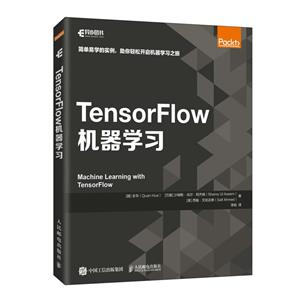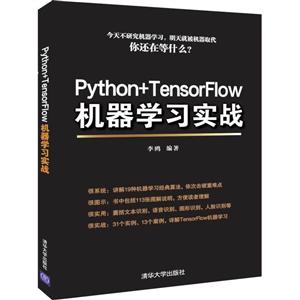
作者:Aurelien Geron著
页数:20,543页
出版社:东南大学出版社
出版日期:2017
ISBN:9787564173715
电子书格式:pdf/epub/txt
内容简介
本书很好地介绍了利用神经网络解决问题的相关理论与实践。它涵盖了构建高效应用涉及的关键点以及理解新技术所需的背景知识。
本书特色
TensorFlow是一个采用数据流图(data flow graphs),用于数值计算的开源软件库。节点(Nodes)在图中表示数学操作,图中的线(edges)则表示在节点间相互联系的多维数据数组,即张量(tensor)。它灵活的架构让你可以在多种平台上展开计算,例如台式计算机中的一个或多个CPU(或GPU),服务器,移动设备等等。本书讲述TensorFlow相关知识。
目录
PrefacePart I. The Fundamentals of Machine Learning 1. The Machine Learning Landscape What Is Machine Learning
Why Use Machine Learning
Types of Machine Learning Systems Supervised/Unsupervised Learning Batch and Online Learning Instance-Based Versus Model-Based Learning Main Challenges of Machine Learning Insufficient Quantity of Training Data Nonrepresentative Training Data Poor-Quality Data Irrelevant Features Overfitting the Training Data Underfitting the Training Data tepping Back Testing and Validating Exercises 2. End-to-End Machine Learning Project Working with Real Data Look at the Big Picture Frame the Problem Select a Performance Measure Check the Assumptions Get the Data Create the Workspace Download the Data Take a Quick Look at the Data Structure Create a Test Set Discover and Visualize the Data to Gain Insights Visualizing Geographical Data Looking for Correlations Experimenting with Attribute Combinations Prepare the Data for Machine Learning Algorithms Data Cleaning Handling Text and Categorical Attributes Custom Transformers Feature Scaling Transformation Pipelines Select and Train a Model Training and Evaluating on the Training Set Better Evaluation Using Cross-Validation Fine-Tune Your Model Grid Search Randomized Search Ensemble Methods Analyze the Best Models and Their Errors Evaluate Your System on the Test Set Launch, Monitor, and Maintain Your System Try It Out!
Exercises 3. Classification MNIST Training a Binary Classifier Performance Measures Measuring Accuracy Using Cross-Validation Confusion Matrix Precision and Recall Precision/Recall Tradeoff The ROC Curve Multiclass Classification Error Analysis Multilabel Classification Multioutput Classification……
Part II. Neural Networks and Deep LearningA. Exercise SolutionsB. Machine Learning Project ChecklistC. SVM Dual ProblemD. AutodiffE. Other Popular ANN ArchitecturesIndex
Why Use Machine Learning
Types of Machine Learning Systems Supervised/Unsupervised Learning Batch and Online Learning Instance-Based Versus Model-Based Learning Main Challenges of Machine Learning Insufficient Quantity of Training Data Nonrepresentative Training Data Poor-Quality Data Irrelevant Features Overfitting the Training Data Underfitting the Training Data tepping Back Testing and Validating Exercises 2. End-to-End Machine Learning Project Working with Real Data Look at the Big Picture Frame the Problem Select a Performance Measure Check the Assumptions Get the Data Create the Workspace Download the Data Take a Quick Look at the Data Structure Create a Test Set Discover and Visualize the Data to Gain Insights Visualizing Geographical Data Looking for Correlations Experimenting with Attribute Combinations Prepare the Data for Machine Learning Algorithms Data Cleaning Handling Text and Categorical Attributes Custom Transformers Feature Scaling Transformation Pipelines Select and Train a Model Training and Evaluating on the Training Set Better Evaluation Using Cross-Validation Fine-Tune Your Model Grid Search Randomized Search Ensemble Methods Analyze the Best Models and Their Errors Evaluate Your System on the Test Set Launch, Monitor, and Maintain Your System Try It Out!
Exercises 3. Classification MNIST Training a Binary Classifier Performance Measures Measuring Accuracy Using Cross-Validation Confusion Matrix Precision and Recall Precision/Recall Tradeoff The ROC Curve Multiclass Classification Error Analysis Multilabel Classification Multioutput Classification……
Part II. Neural Networks and Deep LearningA. Exercise SolutionsB. Machine Learning Project ChecklistC. SVM Dual ProblemD. AutodiffE. Other Popular ANN ArchitecturesIndex















